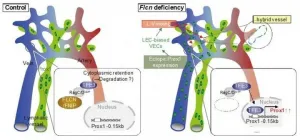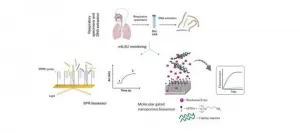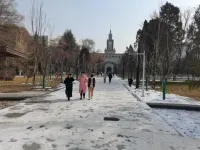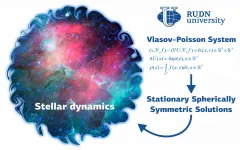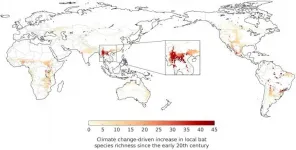(Press-News.org) Researchers from Kumamoto University (Japan) have clarified the mechanism by which blood and lymph vessels remain segregated from one another after development. The characteristics and structures of these two vessel types are very similar, and how they maintain separation has remained unexplained for many years. In this study, researchers found that the molecule Folliculin (FLCN) in vascular endothelial cells acts as a gatekeeper to maintain that separation.
Blood and lymphatic vessels form independent networks until the final confluence at the left and right venous angles in the neck. Blood vessels act as a pipeline that transports oxygen from the lungs to tissues throughout the body. Lymphatic vessels, on the other hand, take in tissue fluids that cannot be collected by blood vessels and act as part of the immune system. However, blood and lymph vessel characteristics and structures are very similar so how they maintain separation from each other has long been a mystery. The elucidation of this mechanism could provide the foundation for the development of novel therapeutic approaches to human lymphatic disorders. For example, the creation of a bypass (a venous-lymphatic shunt) allowing clogged lymphatic flow to return directly to veins would become an innovative therapy for postoperative lymphedema. Thus, researchers around the world have been looking into blood-lymphatic vessel separation mechanisms, but it is still not completely understood.
In this study, researchers first focused on FLCN, the causative gene of a genetic disorder with typical symptoms of multiple lung cysts, kidney cancer, and benign skin tumors (Birt-Hogg-Dube syndrome). They found that mice that were missing the Flcn gene in vascular endothelial cells had abnormal anastomosis between blood and lymph vessels that resulted in fetal death. Furthermore, even in postnatal mice with normal blood and lymphatic vessel separation, induced Flcn gene depletion in endothelial cells caused abnormal anastomosis between the two vessel types.
Flcn deficiency gives rise to lymphatic-biased vascular endothelial cells. These cells cause anastomosis between blood and lymphatic vessels. Prox1* is a central transcription factor in the regulation of lymphangiogenesis and its expression is suppressed by Flcn in venous endothelial cells to maintain the identity of vascular endothelial cells. However, when Flcn regulation in vascular endothelial cells is lost, Prox1 becomes expressed, making venous endothelial cells lymphatic biased. Researchers also found that deletion of Flcn results in the translocation of the transcription factor Tfe3, which is normally in the cytoplasm, into the nucleus where it directly upregulated Prox1 expression. In fact, when Flcn knockout mice were crossed with Tfe3 knockout mice, Prox1 was not expressed in the absence of both Tfe3 and Flcn, and lymphatic biased venous endothelial cells were not seen. These results demonstrate that FLCN acts as a gatekeeper that regulates the plasticity and maintains the separation of blood and lymphatic vessels.
"These results are of great academic importance in that they have clarified a biological question that has gone unanswered for many years: Why do two very similar circulatory systems in the body, blood and lymph vessels, form and maintain independent networks? From a clinical point of view, this has the potential to provide clues on the mechanism of cancer metastasis and can potentially be developed into a treatment for lymphedema," said Associate Professor Masaya Baba, who led the study. "In cancer surgery, lymph node removal can result in serious edema in the upper and lower limbs due to decreased ability to drain lymphatic fluid. Physical therapy, elastic stockings, and lymphovenous anastomosis are listed as treatment methods, but even with skilled microsurgery techniques, it is difficult to treat sufficiently. Out of this research, we envision a future innovative treatment for lymphedema where we can pharmaceutically intervene in the signaling pathway of FLCN to artificially create a shunt that locally connects veins and lymph vessels."
This research was posted online in Nature Communications on 9 December 2020 and was selected as one of Nature Communications Editor's Highlights. The link to the featured article can be found an the translational and clinical research page.
*Prox1 (prospero-related homeobox 1) is a transcription factor that is essential for the development of lymphatic endothelial cells from vascular endothelium cells during development. It is normally expressed specifically in lymphatic endothelial cells and Prox1 is a master gene for the formation of lymphatic vessels. Artificially expressing Prox1 in blood vessels is known to induce their differentiation into lymphatic vessels.
INFORMATION:
Source: I. Tai-Nagara, Y. Hasumi, D. Kusumoto, H. Hasumi, K. Okabe, T. Ando, F. Matsuzaki, F. Itoh, H. Saya, C. Liu, W. Li, Y. Mukouyama, W. Marston Linehan, X. Liu, M. Hirashima, Y. Suzuki, S. Funasaki, Y. Satou, M. Furuya, M. Baba, and Y. Kubota, "Blood and lymphatic systems are segregated by the FLCN tumor suppressor," Nature Communications, vol. 11, no. 1, Dec. 2020.
We've all felt stressed at some point, whether in our personal or professional lives or in response to exceptional circumstances like the COVID-19 pandemic. But until now there has been no way to quantify stress levels in an objective manner.
That could soon change thanks to a small wearable sensor developed by engineers at EPFL's Nanoelectronic Devices Laboratory (Nanolab) and Xsensio. The device can be placed directly on a patient's skin and can continually measure the concentration of cortisol, the main stress biomarker, in the patient's sweat.
Cortisol: A double-edged sword
Cortisol is a steroid hormone ...
The group led by Dr. Enrique J. Calderón - "Clinical Epidemiology and Vascular Risk" at the Institute of Biomedicine of Seville - IBiS/University Hospitals Virgen del Rocío and Macarena/CSIC/University of Seville, also a member of CIBERESP, participated in a project with researchers from CIBER-BBN, in which they developed systems to detect Pneumocystis jirovecii, an atypical fungus responsible for very severe pneumonia in immunosuppressed patients. The results have been published in the journals Nanomaterials and Journal of Fungi, and are the fruit of collaboration with the CIBER-BBN groups led by Dr. Laura Lechuga, ...
The spinal column consists of 24 vertebrae that provide axial support to the torso and protection to the spinal cord that runs through its central cavity. The vertebrae are connected by means of intervertebral discs. These discs are highly hydrated, flexible and highly mechanically resistant. They allow the column its flexibility and act as shock absorbers during daily activities such as walking, running and in impact situations, such as jumping.
These unique features are made possible by the discs' tissue composition and structure. At its centre, there is a gel-like ...
At the time of writing, coronavirus disease 2019 (COVID-19) is seriously threatening human lives and health throughout the world. Before effective vaccines and specific drugs are developed, non-pharmacological interventions and numerical model predictions are essential. To this end, a group led by Professor Jianping Huang from Lanzhou University, China, developed the Global Prediction System of the COVID-19 Pandemic (GPCP).
Jianping Huang is a Professor in the College of Atmospheric Sciences and a Director of the Collaborative Innovation Center for Western Ecological Safety, Lanzhou University, China. He has for a long time been dedicated to studying ...
The Vlasov-Poisson equations describe many important physical phenomena such as the distribution of gravitating particles in the interstellar space, high-temperature plasma kinetics, and the Landau damping effect. A joint team of scientists from the Mathematical Institute of RUDN University and the Mathematical Institute of the University of Munich suggested a new method to obtain stationary solutions for a system of Vlasov-Poisson equations in a three-dimensional case. The obtained solutions describe the phenomena of stellar dynamics. The results of the study were published in the ...
Global greenhouse gas emissions over the last century have made southern China a hotspot for bat-borne coronaviruses, by driving growth of forest habitat favoured by bats.
A new study published today in the journal Science of the Total Environment provides the first evidence of a mechanism by which climate change could have played a direct role in the emergence of SARS-CoV-2, the virus that caused the COVID-19 pandemic.
The study has revealed large-scale changes in the type of vegetation in the southern Chinese Yunnan province, and adjacent regions in Myanmar and Laos, over the last century. Climatic changes ...
Neanderthals' gut microbiota already included some beneficial micro-organisms that are also found in our own intestine. An international research group led by the University of Bologna achieved this result by extracting and analysing ancient DNA from 50,000-year-old faecal sediments sampled at the archaeological site of El Salt, near Alicante (Spain).
Published in Communication Biology, their paper puts forward the hypothesis of the existence of ancestral components of human microbiota that have been living in the human gastrointestinal tract since before the separation between the Homo Sapiens and Neanderthals that occurred more than 700,000 years ago.
"These results allow us to understand which components of the human gut microbiota ...
New research has identified a nanostructure that improves the anode in lithium-ion batteries
Instead of using graphite for the anode, the researchers turned to silicon: a material that stores more charge but is susceptible to fracturing
The team made the silicon anode by depositing silicon atoms on top of metallic nanoparticles
The resulting nanostructure formed arches, increasing the strength and structural integrity of the anode
Electrochemical tests showed the lithium-ion batteries with the improved silicon anodes had a higher charge capacity and longer lifespan
New research conducted by the Okinawa Institute of Science and Technology ...
USC researchers have developed a new method to counter emergent mutations of the coronavirus and hasten vaccine development to stop the pathogen responsible for killing thousands of people and ruining the economy.
Using artificial intelligence (AI), the research team at the USC Viterbi School of Engineering developed a method to speed the analysis of vaccines and zero in on the best potential preventive medical therapy.
The method is easily adaptable to analyze potential mutations of the virus, ensuring the best possible vaccines are quickly identified -- solutions that give ...
The early prognosis of high-risk older adults for amnestic mild cognitive impairment (aMCI), using noninvasive and sensitive neuromarkers, is key for early prevention of Alzheimer's disease. A recent study, published in the Journal of Alzheimer's Disease, by researchers at the University of Kentucky establishes what they believe is a new way to predict the risk years before a clinical diagnosis. Their work shows that direct measures of brain signatures during mental activity are more sensitive and accurate predictors of memory decline than current standard behavioral testing.
"Many studies have measured electrophysiological rhythms during resting and sleep ...
